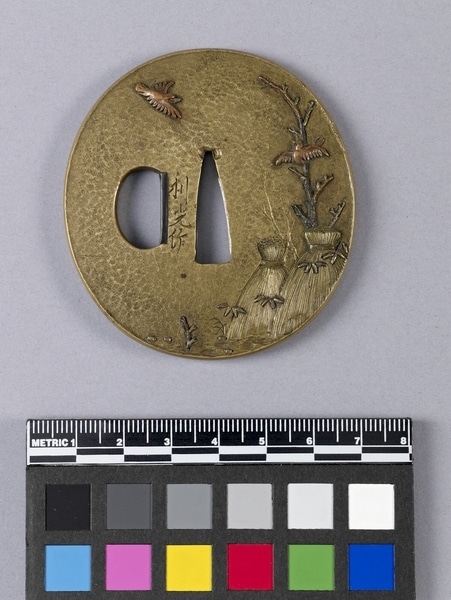Sword Guard Item Number: Ed5.3139 from the MOA: University of British Columbia


Description
Oval-shaped metal sword guard with a triangular hole at the centre and a semi-circular hole to the side. One face has a low relief design of two swallows, a tree and two rice bales, and the reverse depicts a tree trunk and roots. Engraved with Japanese characters. Oval; sentoku, evenly hammered background; nakago ana adjusted with chiselling; open kodzuka adjusted with shakudo insert, no kogai. Signed to left of nakago ana. Front: on right, two slightly raised rice bales with a copper swallow superimposed, a bare branch curving above; another swallow descends from upper left. Back: on lower left a tree root with scattered blossoms at base.
History Of Use
Tsuba, sword guards, are placed between the hilt and blade of a sword, forming an essential guard for the hand, while giving the sword balance. Known to exist in Japan since at least the 8th century, they were plain unsigned metal until about the 16th century, when they became enriched artistic expressions usually made to the order of the individual warrior. The owner’s identity, beliefs and tastes were reflected in the symbols the tsuba bore. The central opening, nakago ana, holds the tang of the blade and often has chisel marks or soft metal inserts as adjustments. It is surrounded by a plain surface, the seppa dai, on which the artist's signature may be found. On either side are the kodzuka and kogai openings, for a knife and a skewer respectively; when both are open the guard is intended for a wakazashi blade (less than two feet) and when one or both are plugged or absent the guard is probably intended for the longer katana blade. This tsuba only has the nakago ana and kodzuka openings, for a katana and utility knife respectively. The artist’s name and the style of the tsuba indicate that this a product of the Nara School of Armourers.
Narrative
Marion Stephan Collection.
Specific Techniques
This tsuba is made of sentoku metal, a special brass alloy containing 10% tin and zinc. Its use was rarer than that of iron, shakudo (bronze with 3% or more gold) or shibuichi (composed of 10% or more silver with four other metals which might be copper, tin, lead or zinc).
Item History
- Made by Toshimitsu Nara (Maker) in Japan between 1800 and 1825
- Collected between 1935 and 1940
- Owned by Marion Stephan
- Owned by Charles H. Stephan before January 4, 1978
- Received from Charles H. Stephan (Donor) on January 4, 1978
What
- Name
- Sword Guard
- Identification Number
- Ed5.3139
- Type of Item
- guard
- Material
- bronze metal, zinc metal, gold metal and tin metal
- Manufacturing Technique
- hammered, incised and inlaid
- Overall
- height 0.3 cm, width 6.0 cm, diameter 6.6 cm
Who
- Culture
- Japanese
- Creator
- Toshimitsu Nara (Maker)
- Previous Owner
- Marion Stephan and Charles H. Stephan
- Received from
- Charles H. Stephan (Donor)
Where
- Holding Institution
- MOA: University of British Columbia
- Made in
- Japan
When
- Creation Date
- between 1800 and 1825
- Collection Date
- between 1935 and 1940
- Ownership Date
- before January 4, 1978
- Acquisition Date
- on January 4, 1978
Other
- Item Classes
- metalwork
- Condition
- good
- Current Location
- Case 79
- Accession Number
- 0428/0023